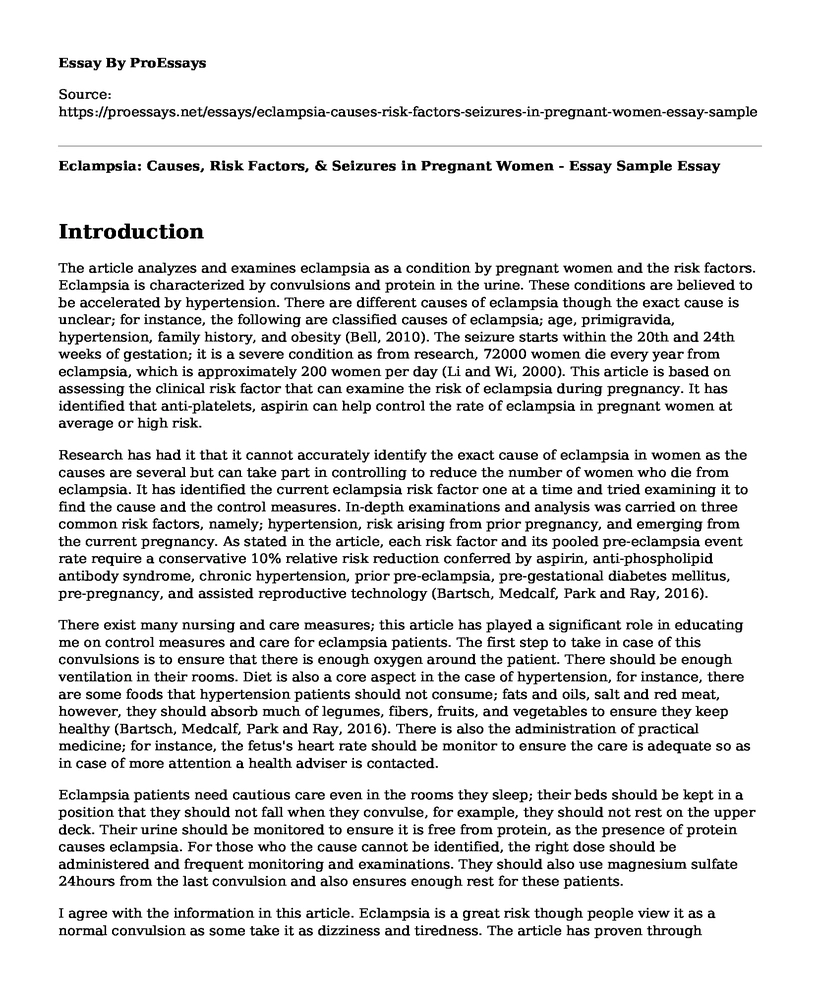Introduction
The article analyzes and examines eclampsia as a condition by pregnant women and the risk factors. Eclampsia is characterized by convulsions and protein in the urine. These conditions are believed to be accelerated by hypertension. There are different causes of eclampsia though the exact cause is unclear; for instance, the following are classified causes of eclampsia; age, primigravida, hypertension, family history, and obesity (Bell, 2010). The seizure starts within the 20th and 24th weeks of gestation; it is a severe condition as from research, 72000 women die every year from eclampsia, which is approximately 200 women per day (Li and Wi, 2000). This article is based on assessing the clinical risk factor that can examine the risk of eclampsia during pregnancy. It has identified that anti-platelets, aspirin can help control the rate of eclampsia in pregnant women at average or high risk.
Research has had it that it cannot accurately identify the exact cause of eclampsia in women as the causes are several but can take part in controlling to reduce the number of women who die from eclampsia. It has identified the current eclampsia risk factor one at a time and tried examining it to find the cause and the control measures. In-depth examinations and analysis was carried on three common risk factors, namely; hypertension, risk arising from prior pregnancy, and emerging from the current pregnancy. As stated in the article, each risk factor and its pooled pre-eclampsia event rate require a conservative 10% relative risk reduction conferred by aspirin, anti-phospholipid antibody syndrome, chronic hypertension, prior pre-eclampsia, pre-gestational diabetes mellitus, pre-pregnancy, and assisted reproductive technology (Bartsch, Medcalf, Park and Ray, 2016).
There exist many nursing and care measures; this article has played a significant role in educating me on control measures and care for eclampsia patients. The first step to take in case of this convulsions is to ensure that there is enough oxygen around the patient. There should be enough ventilation in their rooms. Diet is also a core aspect in the case of hypertension, for instance, there are some foods that hypertension patients should not consume; fats and oils, salt and red meat, however, they should absorb much of legumes, fibers, fruits, and vegetables to ensure they keep healthy (Bartsch, Medcalf, Park and Ray, 2016). There is also the administration of practical medicine; for instance, the fetus's heart rate should be monitor to ensure the care is adequate so as in case of more attention a health adviser is contacted.
Eclampsia patients need cautious care even in the rooms they sleep; their beds should be kept in a position that they should not fall when they convulse, for example, they should not rest on the upper deck. Their urine should be monitored to ensure it is free from protein, as the presence of protein causes eclampsia. For those who the cause cannot be identified, the right dose should be administered and frequent monitoring and examinations. They should also use magnesium sulfate 24hours from the last convulsion and also ensures enough rest for these patients.
I agree with the information in this article. Eclampsia is a great risk though people view it as a normal convulsion as some take it as dizziness and tiredness. The article has proven through research that the risk factors of eclampsia can be controlled, for example, chronic hypertension can be controlled by ensuring a healthy diet and exercise (Bartsch, Medcalf, Park and Ray, 2016). This helps reduce the risk of these conditions, and even if they happen, they will not be severe. Ensuring enough ventilation in the surroundings plays significant roles to these patients as it provides clean air. This research article can be so helpful if heath officer comes across it and educate their patient s on the control measure according to the examinations and analysis were done. This would ensure reduced cases of eclampsia thus would reduce the deaths that happen to pregnant women.
References
Bartsch, E., Medcalf, K. E., Park, A. L., & Ray, J. G. (2016). Clinical risk factors for pre-eclampsia determined in early pregnancy: systematic review and meta-analysis of large cohort studies. Bmj, 353, i1753.
Bell, M. J. (2010). A historical overview of preeclampsiaeclampsia. Journal of Obstetric, Gynecologic & Neonatal Nursing, 39(5), 510-518.
Li, D. K., & Wi, S. (2000). Changing paternity and the risk of preeclampsia/eclampsia in the subsequent pregnancy. American journal of epidemiology, 151(1), 57-62.
Cite this page
Eclampsia: Causes, Risk Factors, & Seizures in Pregnant Women - Essay Sample. (2023, May 04). Retrieved from https://proessays.net/essays/eclampsia-causes-risk-factors-seizures-in-pregnant-women-essay-sample
If you are the original author of this essay and no longer wish to have it published on the ProEssays website, please click below to request its removal:
- Approach to Care in Cancer Patients - Essay Sample
- Synthesis Essay on Abortion
- Laws Relating to Abortion, the Death Penalty, and Assisted Dying Paper Example
- Essay Sample on Role of Empathy in Nursing
- Essay Example on Urban vs. Rural: A Tale of Two Healthcare Systems
- Essay Example on Public Health & Climate Change: Identifying Populations at Risk
- Nursing Communication: Active Listening and Trust - Essay Sample







